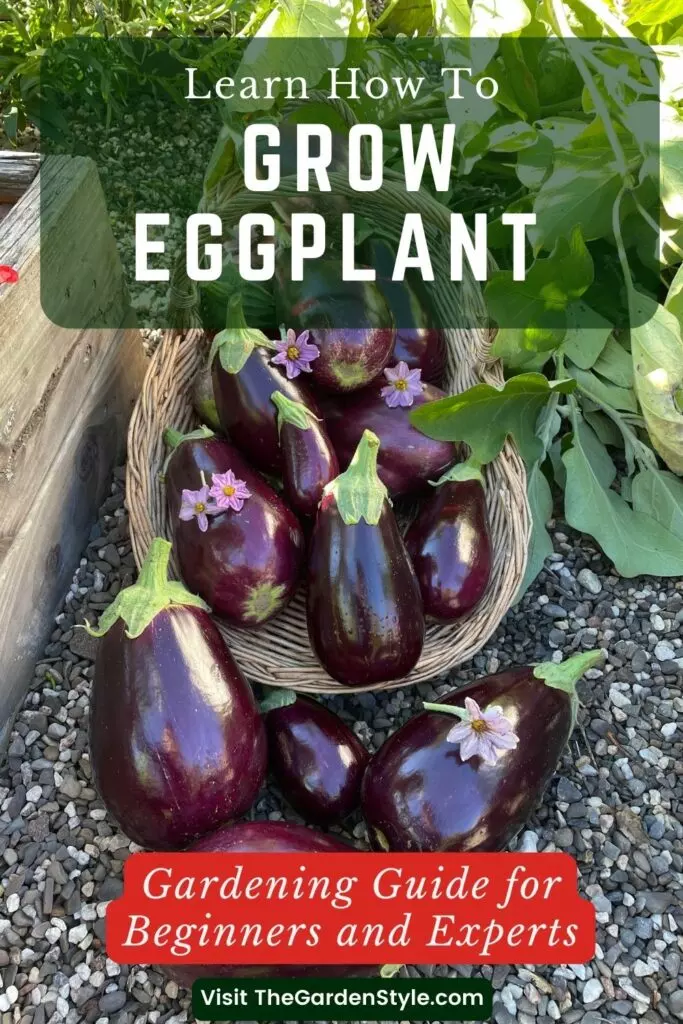Welcome to the ultimate guide to growing eggplant! If you are a beginner gardener, this guide provides detailed explanations of all the key steps you need to grow eggplant plants and have an abundant harvest successfully. In this post, I’ll share my personal experiences and expert eggplant-growing tips on different eggplant varieties from the initial planting phase to harvesting, ensuring you have all the know-how to nurture your eggplant plants until they bear those delicious purple fruits.
Key Takeaways
- Learn to choose the suitable eggplant variety according to your space and growing conditions.
- Discover the process of growing eggplant from seeds and cuttings.
- Explore caring tips for growing robust eggplant seedlings.
- Learn to monitor and address any watering, nutrient, pest, or disease issues to maintain the health and vigor of your eggplant plants throughout their growth cycle.
- Know when and how to harvest your eggplants at the perfect stage of ripeness for the best flavor and quality.
- Be prepared to troubleshoot any growing eggplant problems.
Table of Contents
Choosing the Right Eggplant Varieties for Your Garden
Selecting the perfect eggplant variety for your garden is pivotal for a bountiful harvest. To help simplify the selection process, use an easy-to-use eggplant varieties chart that details characteristics such as size, flavor, and growing conditions.
Eggplant Varieties Chart for Easy Selection
Below is a handy eggplant varieties chart to guide you through some popular options.
| Variety | Size | Flavor | Growing Conditions |
|---|---|---|---|
| Black Beauty | Large | Classic, Mild | Warm, full sun |
| Japanese White Egg | Small | Sweet, tender | Warm, full sun |
| Thai Long Green | Long, slender | Slightly sweet, nutty | Warm, full sun |
| Little Fingers | Small, elongated | Mild, slightly sweet | Warm, full sun |
| Rosa Bianca | Medium, rounded | Rich, creamy | Warm, full sun |
| Casper Eggplant | Medium | Mild, slightly sweet | Warm, full sun |
Best Eggplant Varieties Suitable for Containers or Pots
If you have limited space, don’t fret! Several eggplant varieties thrive in containers and pots, allowing you to grow these delightful plants right on your patio or balcony. The following three varieties are well-suited for container gardening:
- Patio Baby: A compact hybrid variety specifically bred for container gardening, Patio Baby yields small, mildly flavored fruits.
- Fairy Tale: With a delicately sweet flavor and beautiful purple-striped exterior, Fairy Tale is perfect for both ornamental and culinary purposes. It’s also an All-America Selections winner, known for its dwarf habit that makes it suitable for pots and small spaces. Learn more about how to grow fairy tale eggplant.
- Hansel: This versatile, high-yielding variety is known for its elongated, deep-purple fruits. Hansel produces finger-sized fruits that become sweeter if left on the plant longer, making it perfect for container gardens.
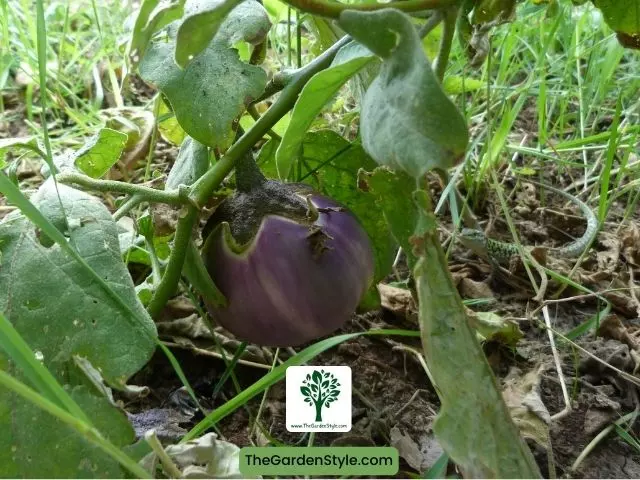
Growing Eggplant from Seeds: A Step-By-Step Approach
Starting eggplants from seeds is a satisfying way to get your garden going. I’ll take you step by step through the germination process and share how to nurture those tiny seeds into strong and healthy seedlings ready for transplanting.
Germinating Your Seeds for Healthy Seedlings
- Soak the seeds: Pre-soak your eggplant seeds in warm water for 6-8 hours. This helps soften the seed coat and accelerates germination.
- Plant the seeds: Sow your seeds in a high-quality seed starting mix, covering them with approximately ¼ inch of soil. Lightly press the soil down to ensure good seed-to-soil contact.
- Moisture control: Water the seedling trays gently, being careful not to disturb the seeds. Maintain a consistent moisture level throughout germination, as both overly dry and wet conditions can impede germination success.
- Temperature: Maintain a consistent soil temperature of around 80-85°F (27-29°C), using a seedling heat mat if necessary, but never higher than 90°F (32°C). This will help the germinating eggplant seeds to thrive.
- Light: Provide 12-14 hours of light daily, either from a sunny windowsill or artificial grow lights. This will ensure the proper growth and development of your seedlings.
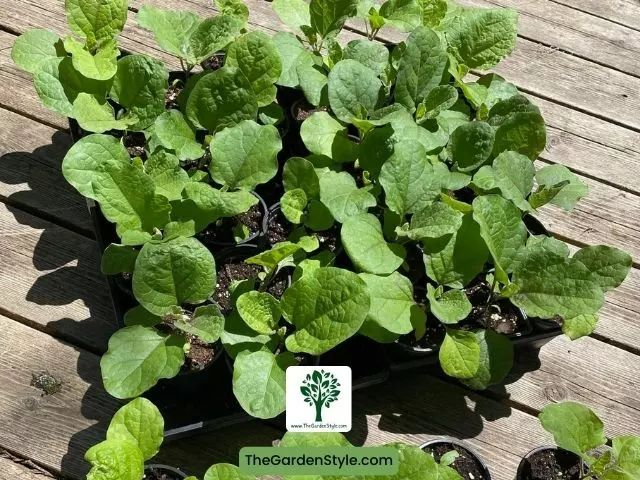
Best Conditions for Seed Growth and Eggplant Growing Stages
The following table summarizes the growing requirements for each eggplant growing stage.
| Stage | Temperature | Light Requirements | Soil Requirements |
|---|---|---|---|
| Germination | 80-85°F (27-29°C) | 12-14 hours daily | Well-draining seed starting mix |
| Seedling | 65-70°F (18-21°C) daytime, 60-65°F (16-18°C) nighttime | 12-14 hours daily | Well-draining potting mix |
| Vegetative growth | 70-85°F (21-29°C) daytime, 65-70°F (18-21°C) nighttime | Full sun (6+ hours daily) | Well-draining garden soil, pH 6.0-7 |
| Fruiting | 70-85°F (21-29°C) daytime, 65-70°F (18-21°C) nighttime | Full sun (6+ hours daily) | Well-draining garden soil, pH 6.0-7 |
Growing Eggplant from Cuttings
If you prefer to save some time during the growing process, growing eggplant from cuttings is a great option. Let’s see the steps:
- Selecting the appropriate cutting
- Preparing the cutting for planting
- Planting and rooting the cutting
- Transplantation and care for cuttings
Selecting the Appropriate Cutting
The first step in growing eggplant from cuttings is selecting the right cutting. Choose a healthy, disease-free, and robust plant to take your cutting from. Preferably, pick a branch that has some new growth but not too much. Your ideal cutting should be 4 to 6 inches long and have a few leaves at the top. The healthier the parent plant, the better chance you have of producing strong and productive offspring.
Preparing the Cutting for Planting
Once you’ve selected your cutting, it’s time to prepare it for planting. Using a sharp, clean pair of gardening shears or a knife, make a diagonal cut at the base of your chosen stem. Remove any remaining flowers or budding fruits and trim the lower leaves, leaving a few leaves at the top. Dip the base of the cutting in a rooting hormone, which will help improve the chances of successful rooting.
Planting and Rooting the Cutting
To plant your eggplant cutting, fill a small pot or container with well-draining soil or a mixture of peat moss and perlite. Create a hole in the soil using a pencil or your finger, and gently insert the bottom half of the cutting into the hole. Lightly firm the soil around the base of the cutting, and water it thoroughly to keep the soil moist but not soggy.
Next, cover the pot with a clear plastic bag or a plastic dome to maintain humidity, which encourages root development. Place the covered pot in a brightly lit location—typically, indirect sunlight is best. Be sure to keep the soil evenly moist during this crucial rooting period, which should take around two to four weeks.
Transplantation and Care for Cuttings
After roots have developed and your cutting has started to show signs of new growth, you can transplant it into a larger pot or directly into the garden. When transplanting, be sure to provide your newly-rooted eggplant with ample space to flourish. Offer additional support, such as stakes or cages, to help the plant grow upright.
In conclusion, growing eggplant from cuttings can be a fun and rewarding process that can save you time and resources, especially if you’d like to replicate a specific variety or maintain a favorite plant. Following these simple steps will help you gain confidence in the art of eggplant propagation and lead you to a thriving and productive eggplant garden.
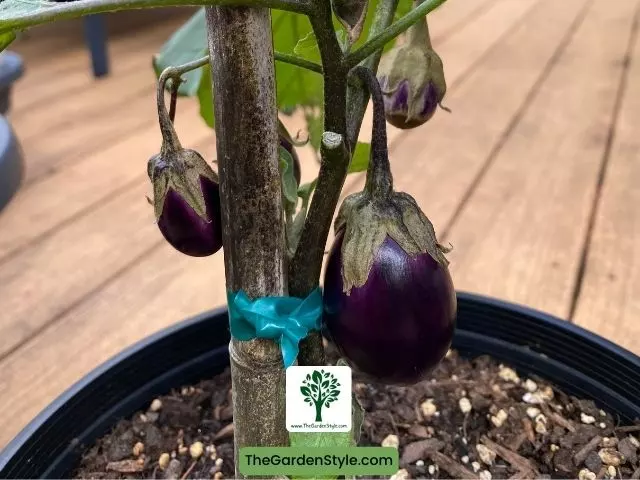
How to Plant Eggplant Step by Step
Soil that hugs your eggplant roots just right can make all the difference in the success of your garden. In this section, I’ll cover the ins and outs of preparing your garden bed and the planting techniques that encourage a strong start for your eggplants. Furthermore, I’ll give you my top spacing tips and layout ideas to maximize your garden’s potential, allowing each plant to flourish.
Soil Preparation and Planting Techniques
Preparing your garden bed for eggplant starts with selecting the right soil. Here’s a straightforward guide to soil preparation for eggplant:
- Choose a well-draining soil mix. Eggplants prefer loamy or sandy soil with a pH between 6.0 and 7. Learn more about how to measure soil pH.
- Work organic matter such as compost, aged manure, or well-rotted leaves into the soil to help improve its structure, drainage, and fertility.
- Loosen the soil to a depth of 12 inches, breaking up any large clumps of dirt and removing any stones or debris.
- Smooth out the soil surface, ensuring the planting area is level.
After preparing the soil, it’s time to start planting eggplants in the garden. Follow these steps:
- Transplant seedlings outdoors after the last frost date, when the soil temperature is at least 60°F.
- Dig a hole large enough to accommodate the root ball.
- Place the eggplant seedling in the hole, ensuring it sits at the same depth as it did in the container.
- Fill the hole back in with the soil, gently firming it around the seedling, and water it thoroughly.
- Mulch around the base of the plant to help conserve moisture and suppress weeds.
Spacing and Layout Tips for Optimal Growth
Providing adequate room for growth is essential for the development and health of your plants. Here are some eggplant planting spacing recommendations:
- Space eggplants about 24 to 30 inches apart within rows.
- Leave about 36 to 48 inches between rows.
- Consider planting eggplant in a staggered arrangement for increased airflow and sunlight penetration.
To optimize your garden layout, consider the following tips:
Intercropping and companion planting can enhance your garden and promote a healthy growing environment. Examples of suitable companion plants for eggplants include bush beans, peas, and peppers.
Rotate your eggplant crops to avoid planting them in the same spot year after year. This practice helps prevent the build-up of diseases and pests in the soil specific to eggplants.
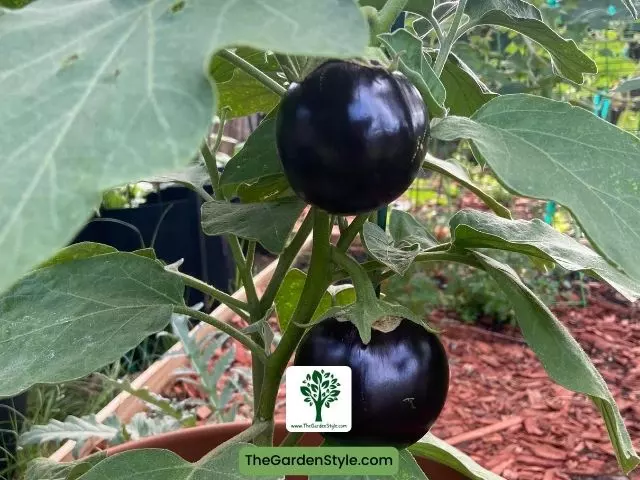
Eggplant Care Tips: Nurturing Your Plants
Proper care for your eggplant plants involves paying attention to their watering and nutrient requirements and preventing pests and diseases. In this section, I’ll provide helpful tips on best practices for these critical aspects of eggplant care.
Watering and Nutrient Requirements
Appropriate watering and fertilizing are crucial for growing healthy eggplants. Here are the key things to consider:
- Eggplant watering: Keep the soil consistently moist but not soggy. It is essential to water the plants deeply, about 1 to 1.5 inches per week. Do not let the soil dry out completely, as this can cause the fruit to become bitter or drop prematurely. Learn more about how often to water eggplant.
- Fertilizing eggplants: To ensure optimum growth, use an organic fertilizer high in phosphorous (2-5-3 ratio) at planting time. Then, side-dress the plants with a nitrogen-rich fertilizer every 4-6 weeks during the growing season.
- Signs of imbalance: Keep an eye out for yellowing leaves or poor fruit development, which might indicate a nutrient deficiency or over-watering. Adjust your watering and fertilizing habits accordingly.
Pest and Disease Prevention for Healthy Eggplants
Effective pest and disease prevention are vital in maintaining your eggplant’s health. Here are some strategies to keep your garden thriving:
- Preventing eggplant diseases: Avoid planting eggplants in the exact location every year, as this increases the risk of soil-borne diseases. Practice good garden hygiene by removing infected plants, debris, and weeds to minimize the spread of disease.
- Managing pests in eggplants: Regularly inspect your plants for signs of pests such as aphids, spider mites, and Colorado potato beetles. Utilize organic remedies like neem oil, insecticidal soap, or beneficial insects (e.g., ladybugs and lacewings) to control pest populations. Discover more about utilizing ladybugs in your garden for effective pest control and natural ecosystem balance.
- Physical barriers: Use row covers and insect netting to prevent pests from accessing your plants. Remove the covers during bloom time to allow for pollination.
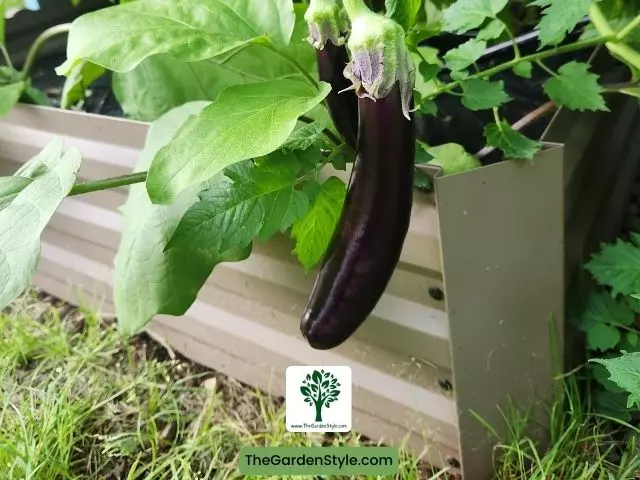
Understanding the Eggplant Growing Stages
With the following summary, I’ll help you comprehend the stages of the eggplant growth cycle so that you are well-equipped to cater to the specific needs of your eggplants during every step of their development.
- Germination and Seedling Stage: After you sow your seeds, they begin to germinate and develop their initial pair of leaves. When you start growing eggplant from cuttings, you kind of skip part of this stage.
- Vegetative Growth Stage: During this stage, your plants will start to grow more leaves and produce a sturdy stem. They will work on building a strong root system, which will help support the plant throughout its life cycle.
- Flowering Stage: Your plants will soon begin to flower, signifying that they are now ready to start producing fruit.
- Fruiting Stage: The moment we all eagerly wait for – the eggplant fruits start to grow and mature. It’s essential to provide sufficient water and nutrients to the plants during this period so that the fruits develop fully and uniformly.
- Harvest Stage: At this point, your eggplants have reached their peak ripeness, and it’s time to harvest. Pick the fruits carefully to avoid damaging the plant or the fruit itself.
In the following table, let’s explore how long the eggplant growing stages will take from day one until harvest and what the key care tips are during the process.
| Eggplant Growing Stages | Description | Duration Since Day 1 | Key Care Tips |
|---|---|---|---|
| Germination and Seedling | Growth of initial leaves and establishment of the plant | 10-20 days | Maintain proper humidity, provide warm temperatures for germination, monitor light exposure |
| Vegetative Growth | Development of leaves, stem, and root system | 30-40 days | Regular watering, application of appropriate fertilizers, adequate sunlight |
| Flowering | Appearance of flower buds and blossoms | Approximately 50-60 days | Extra attention to watering, ensure good pollination, apply phosphorus-rich fertilizers |
| Fruiting | Formation and development of fruits | 70-90 days | Regularly check for pests, support fruiting branches, consistent watering, and fertilizer application |
| Harvest | Picking ripe eggplant fruits | Days to maturity may vary by variety | Harvest carefully, store appropriately |

How Long Does It Take for Eggplant to Grow After Flowering?
It typically takes eggplant around 3 weeks to grow and develop fruit after the flowers are pollinated and fertilized. After successful pollination and fertilization, small eggplant fruit will begin forming behind the flowers.
When and How to Harvest Eggplants
Knowing when to harvest your eggplants is crucial for optimal taste and quality. There are certain signs of ripeness that you can easily observe. If you learn these tips, you’re going to have no problem harvesting at the right time.

Signs of Maturity and Harvesting Techniques
To ensure a prime harvest, look for these signs of ripe eggplants:
- Color: The fruit should have a rich, deep purple or color specific to the variety you are growing.
- Texture: Ripe eggplants will be firm yet slightly springy to the touch.
- Smooth Skin: The skin of a ripe eggplant should be smooth and shiny, without wrinkles or blemishes.
- Size: A mature eggplant will have reached its expected size for the variety. Refer to your seed packet or plant label for size guidelines.
I recommend reading our articles on the harvesting of different varieties of eggplants:
How and When to Harvest Casper Eggplant
How and When to Harvest Japanese Eggplant
How and When To Harvest Eggplant Black Beauty
How and When to Harvest Fairy Tale Eggplant
How and When to Harvest Rosa Bianca Eggplant
Once you’ve determined your eggplants are ripe and ready to harvest, utilize the following tips for a safe and successful harvest:
- Use clean, sharp scissors or pruning shears to remove the fruit. This ensures a clean cut and prevents damage to the plant.
- Leave about an inch of stem attached to the fruit. This will help preserve the fruit’s freshness and prevent spoilage.
- Harvest your eggplants in the morning when they are still cool, as this can extend their storage life.
- Wear gloves when harvesting, particularly if your eggplant variety has small, sharp thorns on the plant.
- Gently handle and transport your harvested eggplants, as they can bruise easily.
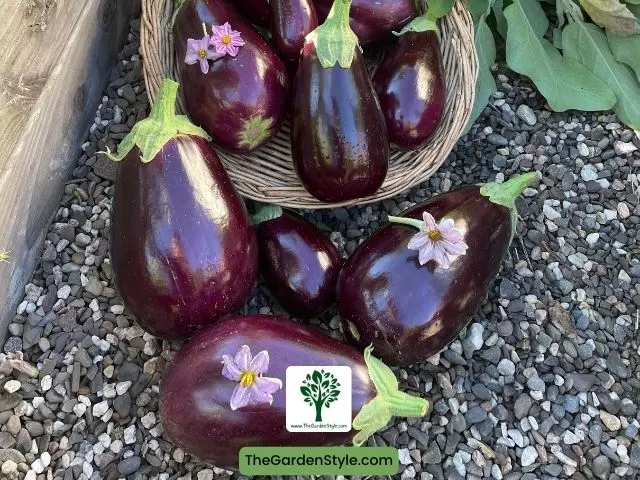
Common Eggplant Growing Problems and Organic Solutions
Let’s look at some of the challenges you may face and how to solve them. Here is a table summarizing common eggplant growing problems and solutions:
| Common Problems | Solutions |
|---|---|
| Leaves yellowing | Check soil pH and amend with dolomitic lime if needed to raise pH closer to 6-7. Ensure adequate nitrogen fertilization. |
| Flowers falling off | Apply calcium nitrate or crushed eggshells. Maintain adequate and consistent soil moisture. |
| Blossom end rot (dark leathery spots) | Choose early-season varieties. Start plants indoors. Use row covers/greenhouses if the climate is too cool. |
| Fruit not ripening | Choose early-season varieties. Start plants indoors. Use row covers/greenhouses if climate is too cool. |
| Curled, puckered leaves | Indication of physiological leaf roll virus. Destroy affected plants immediately. |
| Holes in leaves and fruits | Handpick insect pests like flea beetles, Colorado potato beetles. Apply insecticidal soap. |
| White fungus on soil/plants | Indication of verticillium wilt fungal disease. Solarize soil before replanting next year. |
If this post about growing eggplant was helpful, please share it:

